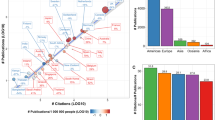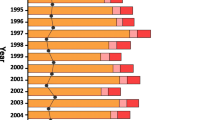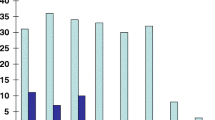Abstract
This paper deals with three types of questions concerning the application of citation analysis. First, it studies the use of citation analysis for assessing national research performance in a research subfield; second, it discusses methodological problems related to the definition of research subfields and to data acquisition; and third, as the data concern four Nordic countries, Denmark, Finland, Norway, and Sweden, attention will be devoted to special problems arising from the application of citation analysis to relatively small countries. These problems are of both methodological and interpretative character.
Similar content being viewed by others
References
T. BRAUN, W. GLÄNZEL, A. SCHUBERT,Scientometric Indicators: A 32-Country Comparative Evaluation of Publishing Performance and Citation Impact, Singaropre & Philadelphia, World Scientific, 1985 (1985a); L. VELHO, The “meaning” of citation in the context of a scientifically peripheral country,Scientometrics, 9 (1986) 71–89.
E.g. B. R. MARTIN, J. IRVINE, CERN, Past performance and future prospects.Research Policy, 13 (1984) 183–210; H. F. MOED et al., The use of bibliometric data for the measurement of university research performance,Research Policy, 14 (1985) 131–149.
E.g. D. HICKS, B. R. MARTIN, J. IRVINE, Techniques for monitoring performance in technologically oriented research. The case of integrated optics,R & D Management, 16 (1986) No. 3, 211–223;Evaluation of National Performance in Basic Research, ABRC Science Policy Studies, No. 1, Department of Education and Science, London 1986.
T. LUUKKONEN-GRONOW, Scientific research evaluation: a review of methods and various contexts of their application,R & D Management, 17 (1987) No. 3, 207–221.
T. BRAUN, W. GLÄNZEL, A. SCHUBERT, Scientometric indicators of Finnish and Hungarian publication performance and citation impact in some fields of science (1976–1980). In:Science and Technology Policies in Finland and Hungary: A Comparative Study; K. O. DONNER, L. PAL (Eds), Budapest, Akadémiai Kiadó, 1985 (1985b). T. BRAUN et al., op. cit., ref. 1, 1985 (1985a).
A. SCHUBERT, S. ZSINDELY, T. BRAUN, Scientometric indicators for evaluation of medical research output of mid-sized countries,Scientometrics, 7 (1985) 155–163.
S. ARUNACHALAM, K. C. GARG, A small country in a world of big science: A preliminary bibliometric study of science in Singapore,Scientometrics, 8 (1985) 301–313.
L. VELHO, op. cit., ref. 1,, 1986.
A. MENDEZ, I. GÓMEZ, M. T. FERNÁNDEZ, G. L. AGUADO, Six years of Spanish scientific activity in physics and engineering through INSPEC and COMPENDEX,,Scientometrics, 12 (1987) 81–100.
Cf. B. R. MARTIN, J. IRVINE, Assessing basic research: Some partial indicators of scientific progress in radio astronomy,Research Policy, 12 (1983) 61–90, and H. F. MOED et al., op. cit., ref. 2, 1985.
E.g. M. H. MACROBERTS, B. R. MACROBERTS, Quantitative measures of communication in science: A study of the formal level,Social Studies of Science, 16 (1986) 151–172; T. A. BROOKS, Private acts and public objects: An investigation of citer motivations,Journal of the American Society for Information Science, 36 (1985) No. 4, 223–229; G. N. GILBERT, Referencing as persuasion,Social Studies of Science, 7 (1977) No. 1. 113–122; M. J. MORAVCSIK, P. MURUGESAN, Some results on the function and quality of ciations,Social Studies of Science, 5 (1975) No. 1, 86–92; D. E. CHUBIN, S. D. MOITRA, Content analysis of references; adjunct or alternative to citation counting?Social Studies of Science, 5 (1975) 423–441; H. ZUCKERMAN, Citation analysis and the complex problem of intellectual influence,Scientometrics, 12 (1987) 329–338.
M. A. FERBER, Citations: Are they an objective measure of scholarly merit?Signs, 11 (1986) No. 2, 381–389.
R. K. MERTON, The Matthew Effect in science,Science, 159 (1968) No. 3810, 56–63; cf. also J. R. COLE, S. COLE,Social Stratification in Science, Chicago and London: University of Chicago Press, 1973.
See above J. R. COLE, S. COLE, op. cit., ref. 13, 1973, 161–215.
All articles having any index term from the whole category “Neoplasms” as the so-called print term were included. Print terms express the main topic of the articles.
F. NARIN, G. PINSKI, H. H. GEE, Structure of the biomedical literature,Journal of the American Society for Information Science, 27 (1976) No. 1. 25–45.
If a Nordic author had collaborated with authors from other countries and had not been the first author, or had written articles while staying abroad and had a foreign address, this work could not be included in the data. This restriction was occasioned by the fact that no lists of Nordic cancer researchers were available for the identification of work in which they had been contributors. It was also assumed that the exclusion of internationally co-authored work in which Nordic authors were not the major contributors or of work carried out while abroad does not affect the country averages considerably. International coauthorships could affect small country counts in small subfields. I have no data on this issue for the subfield of cancer. According to O. PERSSON (private correspondence), the extent of Nordic co-authorships in theSCI is very low; e.g.: 0.7% of the Finnish articles were published with Norwegian authors and 5% of the Norwegian articles with Swedish authors in 1984–87, to mention the lowest and highest extremes. International co-authorships with other countries, e.g. the USA and in selected fields could be higher.
Science Citation Index/ ISI Biomed at DIMDI and SciSearch database at Dialog were used to obtain the citation data. Self-citations were not excluded, mainly due to cost factors and because it was assumed that the rates of self-citation differ too little between the Nordic countries to have an impact on citation rates. The study was carried out in three phases. Citations of articles published in 1981 were checked during wk 12, 1986; citations of articles published in 1982 during wk 26, 1986; and citations of articles published in 1978–80 during wk 2, 1987.
The CHI revised the journals sets in 1981. In cancer the number of journals was increased into 38. They are listed inAppendix 1. Altogether 21% of the Nordic cancer articles in the first set of data appeared in the journals of the larger set. The CHI does not yet provide citation data based on this revision.
T. LUUKKONEN-GRONOW, P. SUUTARINEN,A Bibliometric Analysis of Nordic Cancer Research: A Report of Study Data, FPR publication No. 7, Nordic Science Policy Council, Copenhagen 1988.
This is in accord with the results of a recent study of advances in cancer research which showed that the key papers appeared in general medical or more basic journals of biochemistry, molecular biology, and immunology (Proc. Natl. Acad Sci. (USA), Nature, Cancer, Cancer Research, Blood, J.A.M.A., J Biol. Chem., J Immun, J. Virology, andLancet, in that order), F. NARIN, An Assessment of the Factors Affecting Critical Cancer Research Findings. Final report submitted to the National Cancer Institute, National Institutes of Health, September 30. 1987.
J. R. COLE, S. COLE, The Ortega Hypothesis,Science, 178 (1972) 368–375.
W. E. SNIZEK, A re-examination of the Ortega Hypothesis: The Dutch case,Scientometrics, 9 (1986) 3–11.
The variation of citations by country was tested by variance analysis whereby the value of a variance analysis statistic F was 4.24 for citations per article for the five-year data. The limit value with 0.05 level of significance was 2.60, and thus the result was significant at the level. For each annual subsample the value of F was less than the limit value, and thus not statistically significant. In order to correct the skewedness of citation distributions into more symmetric shapes and thus to correspond better to the assumptions of the test, for each article a transformation to natural logarithm of the number of citations plus one-half was made, as indicated by P. R. MCALLISTER, F. NARIN, J. G. CORRIGAN, Programmatic evaluation and comparison based on standardized citation scores.IEEE Transactions on Engineering Management, Vol. EM-30 (1983) No. 4. 205–211.
See the reference made by J. R. COLE, S. COLE, op. cit., ref. 13, 1973, 162.
The journals and their impact factors for 1983 are:Ann Chir Gynaecol 0.175Ann Clin Res 0.586Med Biol 2.083.
The special subsample of Finnish authors who published in the three Finnish journals in 1981–82 consisted of 19 articles and altogether 45 authors. The number of ciations per paper was 4.4 and number of citation per cited paper 7.6. The same authors contributed to 58 articles during 1978–80 which received 30.3 citations per paper and 32.0 per cited paper. This sample included the article that was cited 811 times, and when it was removed, the articles received 16.6 citations per paper and 17.6 per cited paper. As a comparison, the average citation cound of all Finnish articles published in 1978–80 was 14.3 per paper and 15.8 per cited paper with the article receiving 811 citations removed. In 1981–82 the authors of the subsample contributed to 54 articles other than those published in the three Finnish journals. These were cited 6.7 times per paper and 7.7 per cited paper. Considering only the papers that had been published in other European and American journals, the corresponding citation counts were 7.2 per paper and 8.7 per cited paper. For reasons of comparison, the average Finnish citation performance for articles published in 1981–82 in other European and American journals, the number of citations was 8.1 per apper and 9.5 per cited paper.
F. NARIN, Measuring the research productivity of higher education institutions using bibliometric techniques,OECD Workshop on Science and Technology Indicators in the Higher education Sector. 10th–13th June. 1985, Paris.
J. R. RAVETZ,Scientific Knowledge and its Social Problems, Oxford: Clarendon Press, 1971, 282.
R. B. ARCHIBALD, D. H. FINIFTER, Biases in citations-based ranking of journals,Scholarly Publishing, 18 (1987) No. 2, 131–138.
O. JÄRVINEN, H. PIETIÄINEN, Citation patterns of papers published in Ornis Fennica,Ornis Fennica, 65 (1988) 31–36.
R. K. MERTON, op. cit., ref. 13, 1968.
T. LUUKKONEN-GRONOW, P. SUUTARINEN, op. cit., ref. 20..
Author information
Authors and Affiliations
Rights and permissions
About this article
Cite this article
Luukkonen, T. Publish in a visible journal of perish? assessing citation performance of nordic cancer research. Scientometrics 15, 349–367 (1989). https://doi.org/10.1007/BF02017059
Received:
Issue Date:
DOI: https://doi.org/10.1007/BF02017059




